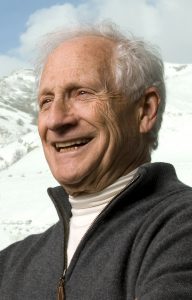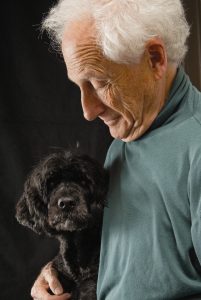 We are sad to report that Dr. Karl Gordon Lark died on April 10th, 2020 from an aggressive form of prostate cancer. Karl Gordon Lark was born on December 13th, 1930 in Lafayette, Indiana to Karl and Betty Lark-Horovitz. His father was a physicist with an interest in biology. Gordon entered the University of Chicago in 1945. Following a course in physical chemistry in 1948, his professor, Leo Szilard, recommended the newly emerging field of molecular biology and, as a good introduction, Gordon took the phage course at Cold Spring Harbor taught by Marc Adams. Subsequently, Gordon enrolled at New York University to obtain his PhD with Marc as his mentor. He became a member of the “Phage Group” of scientists under the guidance of Max Delbrück, using bacterial viruses as a model organism for genetics. This group included the likes of not only Delbrück, but also Luria, Hershey, Meselson, Stahl, Watson and Crick. Gordon obtained his PhD in 1952 and began a lifelong career in molecular biology with his companion and wife, Cynthia Thompson. Gordon Lark emerged as a remarkable scientist not only with an illustrious career in the molecular biology of bacteria and bacteriophages, but he then ventured into new territories including soybean and dog genetics. In each of these fields a hallmark of Gordon’s pursuits were clarity, passion and creativity. How he managed, with only a modest-sized laboratory, to significantly contribute to such a diverse set of fields was, and still is, truly amazing.
We are sad to report that Dr. Karl Gordon Lark died on April 10th, 2020 from an aggressive form of prostate cancer. Karl Gordon Lark was born on December 13th, 1930 in Lafayette, Indiana to Karl and Betty Lark-Horovitz. His father was a physicist with an interest in biology. Gordon entered the University of Chicago in 1945. Following a course in physical chemistry in 1948, his professor, Leo Szilard, recommended the newly emerging field of molecular biology and, as a good introduction, Gordon took the phage course at Cold Spring Harbor taught by Marc Adams. Subsequently, Gordon enrolled at New York University to obtain his PhD with Marc as his mentor. He became a member of the “Phage Group” of scientists under the guidance of Max Delbrück, using bacterial viruses as a model organism for genetics. This group included the likes of not only Delbrück, but also Luria, Hershey, Meselson, Stahl, Watson and Crick. Gordon obtained his PhD in 1952 and began a lifelong career in molecular biology with his companion and wife, Cynthia Thompson. Gordon Lark emerged as a remarkable scientist not only with an illustrious career in the molecular biology of bacteria and bacteriophages, but he then ventured into new territories including soybean and dog genetics. In each of these fields a hallmark of Gordon’s pursuits were clarity, passion and creativity. How he managed, with only a modest-sized laboratory, to significantly contribute to such a diverse set of fields was, and still is, truly amazing.
In 1970 Gordon Lark was recruited to the University of Utah to assemble a new Department of Biology that would include all of the biological sciences, from molecular biology to ecology and evolutionary biology. In the first six years he hired seventeen new tenure-track faculty. His energy was boundless, his formula simple. He looked for excellence, creativity and synergy. The latter he interpreted as having passion for science and the need to share that passion, particularly with the next generation of scientists. In a few years, Gordon’s vision, tenacity and impeccable taste established a world class Biology department that was particularly well-recognized for its excellence in genetics. New recruits learned so much from Gordon, who taught by example. His rigor, diligence and attention to detail were unparalled. He set very high bars for himself and his science, with those around him sometimes struggling to keep up. But, perhaps surprisingly given his boundless energy, Gordon was in some ways a very patient man. Before every critical faculty vote Gordon would take time to personally discuss this issue with every member of the department. When the vote came, there were no surprises.
 The dog genetics community owes a special thanks to Gordon for his seminal contributions. His PNAS paper in 2002 with Kevin Chase revolutionized the field, demonstrating for the first time that seemingly complex morphologic traits were controlled by a small number of genes, thus nominating the dog as a genetic system for the identification of genes controlling breed-specific differences in morphology and behavior. That paper also provided a key impetus to select the dog as a mammal for early whole genome sequencing in 2005, which in turn allowed canine genetics to blossom as a system of interest to medical geneticists, anthropologists, behavioral scientists and physiologists.
The dog genetics community owes a special thanks to Gordon for his seminal contributions. His PNAS paper in 2002 with Kevin Chase revolutionized the field, demonstrating for the first time that seemingly complex morphologic traits were controlled by a small number of genes, thus nominating the dog as a genetic system for the identification of genes controlling breed-specific differences in morphology and behavior. That paper also provided a key impetus to select the dog as a mammal for early whole genome sequencing in 2005, which in turn allowed canine genetics to blossom as a system of interest to medical geneticists, anthropologists, behavioral scientists and physiologists.
Gordon was unique in his ability to make connections where no one else saw them. He frequently drew parallels between his soybean and dog work, pointing out that interactions between quantitative trait loci in soybeans were key for understanding phenotypic variation. He argued, correctly, that the same must be true in dogs, likely explaining some of the nuanced changes observed between breeds. The “Georgie Project,” an effort to fully sample large numbers of living Portuguese Water dogs is just one example that can be pointed to when a trainee says “…I can’t possibly…,” reminding them that if Gordon could do it, they can at least try.
Gordon Lark created a space of trust and synergy, rather than competition, a place that inspired, was rigorous but also joyful. The surrounding environment in Utah is magnificent, and its splendor matched the environment Gordon built in his department. It is doubtful that any achievements which we have been fortunate to accrue could have been attained in any other environment. Utah was and is a place where people like Gordon could think big, and then bigger still, with unfettered creativity. Those of us living in other places found reasons to visit Gordon frequently, believing that our collaborations with him would somehow make us heirs to his success.
Our final mental pictures of Gordon are not of him at the bench, but of him with Mopsa, his all-time favorite dog, sitting beside him in his messy office as Gordon talked with unbridled enthusiasm about the achievements of his family, and his love of music, literature, and history. We will all miss Gordon. In these very strange times of social distancing, it is difficult to grieve together. However, such grieving, in Gordon’s eyes, would likely be displaced. What would please Gordon most is for us as scientists to continue our endless quests for the joy of doing science and, most of all, to share that joy with the next generation of scientists.
Mario R. Capecchi
University of Utah School of Medicine
Elaine A. Ostrander
National Human Genome Research Institute/NIH













